
Reinterpretation of the RRISP-77 Iceland Shear Wave Profiles
W. Menke, B. Brandsdottir, P. Einarsson and I. Bjarnason
Geophys. J. Int., 1996
Abstract
Two shear wave profiles, E and G, collected during the 1977 Reykjanes Ridge Iceland Seismic Experiment have played an important role in models of the Icelandic crust. They were originally interpreted as indicating very low shear wave velocities and abnormally low shear wave quality factors in the 10-15 km depth range. These attributes, which are indicative of near-solidus temperatures, were used to support the hypothesis that the crust of Iceland is relatively thin (10-15 km) and underlain by partially molten material. More recent seismic data, however, contradict this hypothesis and suggest that the crust is thicker (20-30 km), and cooler. A reexamination of the RRISP-77 data indicates that the low shear wave velocities are artifacts arising from source static anomalies (in the case of Profile G) and misidentification of a secondary shear phase, SmS, as S (in the case of the E Profile). Furthermore, the attenuation occurs at ranges when rays from the shots pass near the Askja (profile E), and Katla and Oraefajokull (Profile G) volcanoes. It may therefore have a localized source, and not be diagnostic of Icelandic crust as a whole. This new interpretation of the RRISP-77 shear wave data is consistent with models having a thick, cold crust.
(Top) RRISP shear wave profile, showing interpretation of shear arrivals as S and SmS waves. (Bottom) Synthetic seismograms computed for 30 km thick crust. near Katla volcano recorded on the USGS/U. Durham array at Hengill.
Text
Figures